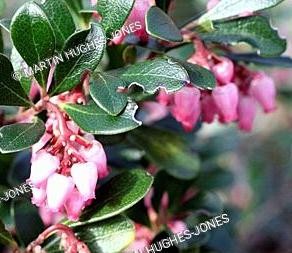Caucasian Whortleberry
(Vaccinium padifolium)

Description
Vaccinium arctostaphylos or Caucasian whortleberry is a species of shrub with edible fruit of blue color. It is native to Western Asia (Iran and Turkey), the Caucasus (Armenia; Azerbaijan; Georgia; Russia), and Southeastern Europe (Bulgaria). In a study on 50 hyperlipidaemic adult patients, an extract of the fruit of Vaccinium arctostaphylos was found to have beneficial effects on serum lipid profile and oxidative stress. Each medicinal capsule contained 45 ± 2 mg of anthocyanins. The authors suggest that the effects may be due to the anthocyanin content of the fruit. Vaccinium is a common and widespread genus of shrubs or dwarf shrubs in the heath family (Ericaceae). The fruits of many species are eaten by humans and some are of commercial importance, including the cranberry, blueberry, bilberry (whortleberry), lingonberry (cowberry), and huckleberry. Like many other ericaceous plants, they are generally restricted to acidic soils. The plant structure varies between species: some trail along the ground, some are dwarf shrubs, and some are larger shrubs perhaps 1 to 2 m (3 to 7 ft) tall. Some tropical species are epiphytic. Stems are usually woody. Flowers are epigynous with fused petals, and have long styles that protrude from their bell-shaped corollas. Stamens have anthers with extended tube-like structures called "awns" through which pollen falls when mature. Inflorescences can be axillary or terminal. The fruit develops from an inferior ovary, and is a four- or five-parted berry; it is usually brightly coloured, often being red or bluish with purple juice. Roots are commonly mycorrhizal, which likely help the plants to access nutrients such as nitrogen and phosphorus in the acidic, nutrient-poor soils they inhabit. The genus was first described scientifically by Carl Linnaeus in 1753. The name Vaccinium was used in classical Latin for a plant, possibly the bilberry or a hyacinth, and may be derived from the Latin bacca, berry, although its ultimate derivation is obscure. It is not the same word as Vaccinum "of or pertaining to cows". The taxonomy of the genus is complex, and still under investigation. Genetic analysis indicates that the genus Vaccinium is not monophyletic. A number of the Asian species are more closely related to Agapetes than to other Vaccinium species.
Taxonomic tree:







